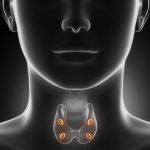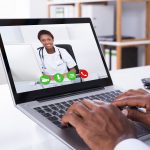Polarity Analysis Homeopathy & Stress Adaption: Two Case Studies
TIM SHANNON, ND, DHANP
Stress is a ubiquitous challenge in today’s modern life, especially today when a plethora of potential triggers can increase stress in our patients. The pandemic lockdown, current politics, economic challenges, and racial disparity are all examples of this. Of course, stress can also be readily found in the context of our relationships: divorce, deaths, recalcitrant children, etc.
For many patients, an increase in perceived stress can worsen or initiate a multitude of ailments. Current research suggests that a patient’s increased subjective sense of stress can alter their physiology in significant ways1-4 and that chronic symptoms tend to be exacerbated in tandem with a sense of increased stress.5-7
There are many examples of this in the clinic. For instance, it is common for some patients to register stress physically with significant – and sometimes intractable – changes in breathing, pulse rate, body temperature, appetite, sleep habits, and many other changes.
Although clinicians often think of these changes as alterations in homeostasis, that is not quite accurate. The more appropriate term for these alterations in adaptation is the term “allostasis.”7-9 This is a concept that defines how the body-mind can alter its physiology when attempting to adapt to a perceived stress. Homeostasis, on the other hand, refers more to physiological changes germane to survival. Allostatic alteration can be destructive, neutral, or helpful.
Recent research has examined how nanoparticles (a particle that is 1-100 nanometers in diameter), such as are used in homeopathic medicine, can promote systemic alterations that help reinstate healthy allostasis.10-13
The following 2 case reports are examples from my practice of patients who were both struggling with chronic stress and who were successfully treated using polarity analysis (PA) homeopathy. The first case study is of a woman who was served divorce papers. This was a shock to her and unfortunately triggered a cascade of intractable health complaints. The second case study is of a young man who felt significant existential challenges along with anxiety from myriad changes in his life. In addition to feeling threatened by a roommate, his employer’s coronavirus lockdown actions caused him ongoing stress. As a consequence, he developed a plethora of intractable symptoms.
In my own practice, I see several patients each week who are referred for significant chronic stress-based challenges. I have been heartened by the wonderful alacrity and efficiency of PA homeopathy in helping most of these patients. This is partly due to the efficacy of homeopathy itself. However, PA makes the process infinitely easier and faster and the results more certain.
Please see my article in the 2020 December issue of NDNR for an explanation of PA homeopathy.14 Of course, the books by the founder of PA – Dr Heiner Frei15-17 – and his website18 are other important resources.
Case Study 1
A 45-year-old female presented to my office on May 7, 2020.
“I got divorced, and the emotional part is really hitting me,” she told me. “Everything is making me cry. That’s not me, not my personality. A lot of it is due to him leaving me for someone 20 years younger, and they are already having a baby. I’m just sad, and I’m tired of being sad. How long? Our divorce was final the day after Christmas; then in February they were getting married. Then I found out 3-4 weeks ago that they’re having a baby. I’m angry and sad. Sleep? I just don’t feel tired at night; I don’t ever want to go to bed. Of course, with the poor sleep, I’m also feeling tired most days.”
I developed a baseline of subjective symptoms to better follow the patient across encounters:
- Depression/Weepy: 3-4 times per week
- Difficulty initiating sleep: 7 times per week
- Difficulty staying asleep: 6-7 times per week
- Overeating: 3-4 evenings per week
- Fatigue: on most days
Assessment & Recommendation: The patient was experiencing a clear downturn due to a recent shock, and this had become an ongoing stress. The above baseline suggests she had become stuck in an adrenal burnout syndrome where she was not sleeping well, was stress-eating, was experiencing significant emotional lability and depression, and, as a consequence, was feeling markedly more fatigued. Unfortunately, despite the patient working on these issues with her regular doctor (a naturopathic doctor) from January until March, the patient’s symptoms had proven intractable. As a result, the patient was referred for a homeopathic workup.
Based on my initial repertorization (Figure 1), I selected Strontium carbonicum 6c as the first trial remedy for this patient, at a dose of 4 drops every other day (3 pellets were dissolved in 80/20 H20/alcohol). It turns out this was short-sighted.
Figure 1. Case 1: Repertorization 1
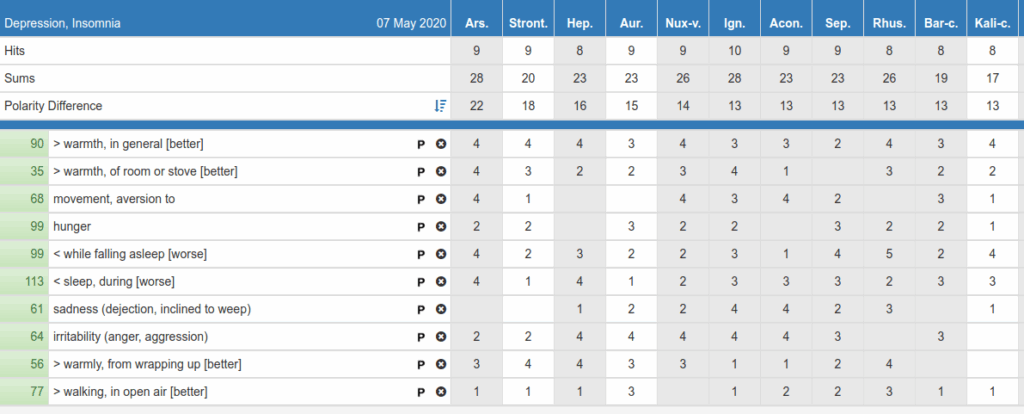
Follow-up Visits
Follow-up, May 20, 2020
The patient reported, “I started the remedy right away. I do feel more evened out. However, I started to feel excessive stress again. Also, my sleep is worse.”
Assessment & Recommendation: Although there was some improvement, evaluation of her baseline was deferred given the quick downturn regarding stress and the worsening sleep. I worked with the patient to refine my analysis (Figure 2). With confirmation, I recommended that she take Aurum metallicum 3c, 4 drops daily.
Figure 2. Case 1: Repertorization 2
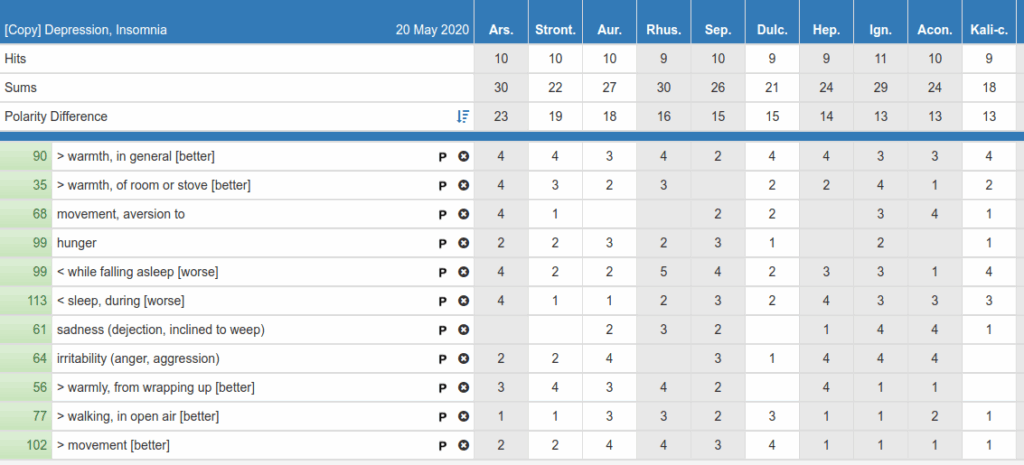
Follow-up, June 11, 2020
The patient had been on the remedy for only a week and a day (due to a delay in obtaining it). When I asked the patient about her baseline symptoms, she said, “I’m better. For starters, I’m not needing sleep aids. I can get to sleep and now stay asleep. Before, I would wake up and my mind would go 1000 miles an hour. It’s so nice to be relieved of that!” Her depression and weepiness was also much better: “My ex-husband posted pictures on Facebook and I didn’t get upset or cry. I feel like I’m evening out.” The overeating was also better. She had lost 4 lb over the previous 2 weeks.
Follow-up, July 23, 2020
When I asked the patient how she was doing, she said, “I’m doing well, sleeping great, and really have no depression to speak of. I’m definitely more accepting. In addition, when stress comes on at work, I’m handling it well.” I asked her if she was symptom-free or if she had some residual issues. “I’ve had some days when I forgot to take the drops and I felt more anxious.” Did she regress completely? “No, I just would wake up and feel a bit anxious.”
Assessment & Recommendation: Baseline evaluation was deferred given that the patient’s symptoms were much improved.
Follow-up, October 1, 2020
The patient reported, “I am doing well. I’m occasionally a bit anxious, but a few drops mop it up. I’m probably 70-80% better. I was in bad shape when we started.” I asked her what symptoms or challenges remained. “Things are so different. I feel more anxious now because working from home, my kid is at home, plus there’s some lockdown-related stress. My relationship with my ex brings its own ongoing issues. But now it’s more of the stress of home and lockdown.” When I asked her if the remedy appeared to address her current stress, she said, “Yes. When I take the drops, it works. The divorce brought on a more significant anxiety/depression, but that really is resolved; I’m at peace with it.”
Assessment & Recommendation: Baseline evaluation was deferred, since the patient was doing so well. However, to continue the forward momentum, I recommended she start on a higher potency of the remedy: Aurum LM1 daily.
I last talked with the patient, via Zoom, on November 25th about a recent upper respiratory infection. She had dosed herself a few times with Pulsatilla, which quickly mopped up the symptoms. Because her mental/emotional symptoms were still resolved, I cancelled our next-scheduled follow-up and sent her back to the referring doctor for further care.
Case Study 2
A 30-year-old male Amazon employee presented to my office on July 2, 2020.
“These last 10 months have been challenging,” he told me. “Last year I went to Canada, in the back country, to do a spiritual journey. I’ve been dealing with some psychological issues. I was doing well, and then the virus hit, and a few weeks into quarantine I was threatened by a roommate. I had a panic attack. My heart rate went up into the 170s, I was shaking uncontrollably and became chilled. I have a very poor memory. What I can recall is that my life was going past my eyes. I had many epiphanies.
“Since then, I’ve had small panic attacks. I’ll be washing the dishes and suddenly start questioning if this is really happening, like wondering if I’m really here. I’m concerned about my challenge with contact with reality. I’ve agreed to go back to work, though it seems like there’s little protection for me there; I’m high risk. [The patient has a congenital heart condition.] Five years ago, my biological father physically threatened me. I think that was what triggered my panic attacks. The main issue is my mental state. Cannabis use might have also impacted my panic attacks.”
I asked him to elaborate on the anxiety. “My heart rate alternates too fast or slow. I also have shortness of breath, some dizziness, and fear of death. Watching a movie or doing a video game can elevate my heart rate. I fear death and I fear the un-lived life. But a big one is questioning whether things are real, whether I’m actually here. Maybe I’ve actually died, or maybe I’m in a coma. Or life as a whole … maybe this is all a hallucination. I’m trying to find some universal theory to ground myself.”
I asked him if he has physical symptoms that accompany these feelings. He said, “My vision is clear, but also distorted at the same time. It feels like I’m peeking through a hole in a wall – like peeking through eyes to see reality. I also can’t sit still. If I’m sitting, I’m usually bouncing my leg. I’m often looking around to observe my surroundings. I’m not having any changes in temperature or sweating. I tried some microdosing of mushrooms, which seemed to help.”
I asked him about his past health history. “In utero, I had a ventricular septal defect, and I had surgery for an enlarged heart at age 9. After that, the cardiologist said that I’ll always live with heart issues. I might eventually have to have another surgery and I have to be cautious with various activities.” When I asked him about concentration and focus, he replied, “I find that doing film or photo work is very grounding to me. Music is next up in being helpful.”
The review of his baseline symptoms was as follows:
- Background anxiety: daily intensity was 3-4/10
- Heart palpitations (often preceding anxiety): on most days
- Difficulty falling asleep; and more intense anxiety with shortness of breath; fear of dying in his sleep: on most nights
- Double-checking his reality on waking: every morning
Assessment & Recommendation: After repertorizing the patient’s case (Figure 3) and consulting the materia medica, I I recommended he take Spongia 6x, 4 drops daily.
Figure 3. Case 2: Repertorization
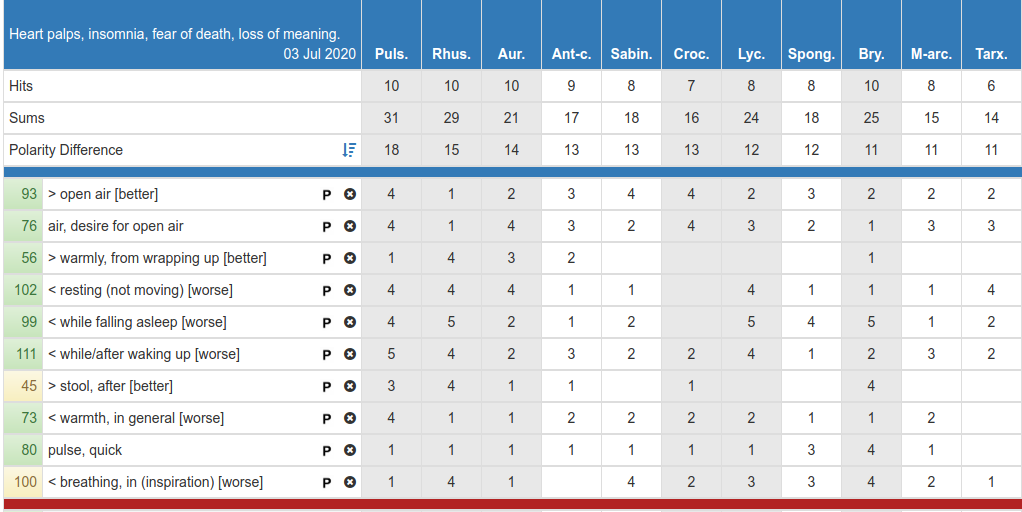
Follow-up Visits
Follow-up, July 17, 2020
I asked the patient how he was doing. “I’m better in some regards. The remedy is definitely helping with the anxiety; that’s been a major improvement.” When I asked him how soon after starting the remedy he noticed an improvement, he said it took about 4 or 5 days for it to become apparent. He continued: “But the thing that’s not changed is the existentialism stuff. The anxiety around my mortality has definitely declined. But the existentialism is still there. The universe is around us; we are biological organisms existing on a rock going through space. There’s some loss of meaning for me and for the world. My suffering around that has reduced along with the anxiety. However, I’m still faced with uncertainty, as a whole, and my purpose.”
Reviewing his baseline symptoms, the intensity of his background anxiety had decreased from 3-4/10 to 1-2/10. On most days, he no longer felt the heart palpitations that would often precede the anxiety. The symptoms associated with sleep – difficulty falling asleep, more intense anxiety with shortness of breath, and fear of dying in his sleep – had stayed about the same until the last 2 nights, which were better. The tendency to double-check and doubt his reality on waking was the same, though less debilitating. “The questioning of reality isn’t there as much. But I’ve been expecting that I’d die in my sleep. Lately, I’ve been waking up a bit surprised to find that I’m still here.”
Assessment & Recommendation: The patient was significantly better after roughly 2 weeks. However, we needed to see a progressive improvement over a longer period of time. Therefore, I recommended he continue with the dose as prescribed at our last encounter.
Follow-up, August 27, 2020
The patient reported that he was a lot better. I asked him what was not better, or what was remaining. “Up until recently, I would have some small ‘mini’ episodes of anxiety trying to sleep. It’s the closing of my eyes and fearing that I wouldn’t wake up. I was still feeling some of that existentialism. I took some microdoses of mushrooms, which also helped. There are some moments of questioning my existence, but not problems or issues. Those moments can bring up some anxiety, but I’m able to just move on if I get a bit uncomfortable.” I asked him to rate how much better he was now. He said, “About 85%. The remaining 15% may be just normal to being human. I’ve been taking the remedy every other day for the last 2 weeks since feeling more stable.” He denied having other questions or concerns.
Reviewing his baseline symptoms, his background anxiety was still less and did not really include the mortality aspect. He was no longer experiencing heart palpitations before anxiety. Regarding his nighttime symptoms, he said the remedy hadn’t helped with falling asleep, but he’d noticed a gradual reduction in anxiety. “It took 2 to 2 ½ weeks before I felt more functional during the day.” I asked him about having to double-check his reality on waking. “That’s mostly resolved.”
Assessment & Recommendation: Given his overall good progress, I suggested he continue with his current dosage.
Follow-up, September 18, 2020
I asked the patient how he was doing. “I still experience some disassociation, but I’m still doing a lot better with the anxiety. It’s mostly resolved. However, I can’t return to work due to my risk status. They are saying I’ll be terminated. They said that your doctor’s note is insufficient.”
A review of his baseline symptoms indicated that his background anxiety had fully resolved. On most days, he still had no heart palpitations. Nighttime symptoms were all resolved, including falling asleep normally. Even having to double-check his reality on waking was mostly resolved.
Assessment & Recommendation: Most of the patient’s issues were resolved. I recommended he continue the Spongia dosing at 2 times per week, but suggested he gradually taper off the remedy unless any previous issues returned. And if any challenges were to come to the fore, he should schedule a follow-up visit or reach out via the portal.
References:
- Berger I, Werdermann M, Bornstein SR, Steenblock C. The adrenal gland in stress – Adaptation on a cellular level. J Steroid Biochem Mol Biol. 2019;190:198-206.
- Tawakol A, Osborne MT, Wang Y, et al. Stress-Associated Neurobiological Pathway Linking Socioeconomic Disparities to Cardiovascular Disease. J Am Coll Cardiol. 2019;73(25):3243-3255.
- Washington TD. Psychological stress and anxiety in middle to late childhood and early adolescence: manifestations and management. J Pediatr Nurs. 2009;24(4):302-313.
- Frodl T, O’Keane V. How does the brain deal with cumulative stress? A review with focus on developmental stress, HPA axis function and hippocampal structure in humans. Neurobiol Dis. 2013;52:24-37.
- Kirschbaum C, Prüssner JC, Stone AA, et al. Persistent high cortisol responses to repeated psychological stress in a subpopulation of healthy men. Psychosom Med. 1995;57(5):468-474.
- McEwen BS, Stellar E. Stress and the individual. Mechanisms leading to disease. Arch Intern Med. 1993;153(18):2093-2101.
- McEwen BS. Protective and damaging effects of stress mediators: central role of the brain. Dialogues Clin Neurosci. 2006;8(4):367-381.
- McEwen BS. Stress, adaptation, and disease. Allostasis and allostatic load. Ann N Y Acad Sci. 1998;840(1):33-44.
- McEwen BS, Gianaros PJ. Stress- and allostasis-induced brain plasticity. Annu Rev Med. 2011;62:431-445.
- Bell IR, Koithan M, Brooks AJ. Testing the nanoparticle-allostatic cross-adaptation-sensitization model for homeopathic remedy effects. Homeopathy. 2013;102(1):66-81.
- Bell IR, Koithan M. A model for homeopathic remedy effects: low dose nanoparticles, allostatic cross-adaptation, and time-dependent sensitization in a complex adaptive system. BMC Complement Altern Med. 2012;12:191.
- Bell IR, Sarter B, Standish LJ, et al. Low Doses of Traditional Nanophytomedicines for Clinical Treatment: Manufacturing Processes and Nonlinear Response Patterns. J Nanosci Nanotechnol. 2015;15(6):4021-4038.
- Bell IR, Schwartz GE. Enhancement of adaptive biological effects by nanotechnology preparation methods in homeopathic medicines. Homeopathy. 2015;104(2):123-138.
- Shannon T. Polarity Analysis Homeopathy: Two Women’s Health Cases. NDNR. 2020;16(12):12-15.
- Frei H. Polarity Analysis in Homeopathy: A Precise Path to the Simillimum. Kandern, Germany: Narayana Verlag GmbH; 2013.
- Frei H. Homeopathy and ADHD. Kandern, Germany: Narayana Verlag GmbH; 2015.
- Frei H, Everts R, Von Ammon K, et al. Homeopathic treatment of children with attention deficit hyperactivity disorder: A randomised, double blind, placebo controlled crossover trial. Eur J Pediatr. 2005;164(12):758-767.
- Heiner Frei MD. Polarity Analysis. 2014. Available at: http://www.heinerfrei.ch/polarity-analysis. Accessed November 24, 2020.

Tim Shannon, ND, DHANP specializes in cancer care, mental health, anti-aging therapy, men’s health, and general wellness. His approach to cancer includes supportive care for patients receiving conventional treatment, and alternative treatment for cancer patients when conventional treatments are inappropriate or unwanted. Dr Shannon’s primary modality is a type of classical homeopathy called Polarity Analysis. He also teaches the Polarity Analysis. In addition, his treatment plans emphasize diet and lifestyle changes when appropriate. For recreation, Dr Shannon enjoys hiking, roller blading, family bike trips, Qigong, and general family time.






